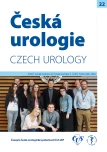Extended recommendation for management of paediatric enuresis
Authors:
Marcel Drlík 1; Hana Flögelová 2; Zdeněk Dítě 1; Jan Trachta 3
Authors‘ workplace:
Centrum dětské urologie, Urologická klinika, VFN a 1. LF UK, Praha
1; Dětská klinika, LF Univerzity Palackého a Fakultní nemocnice, Olomouc
2; Klinika dětské chirurgie 2. LF UK a FN Motol, Praha
3
Published in:
Ces Urol 2018; 22(3): 164-175
Category:
Review article
Overview
Enuresis, more specifically night-time intermittent urinary incontinence, is defined as urine leakage during sleep in children over 5 years of age. It is a very common problem affecting about 15 % of children aged 5 years, persisting in 2 % of the adult population. Recommendations for Diagnosis and Treatment of Children with Enuresis – are the result of the joint efforts of the Paediatric Urology Section of the Czech Urological Society and the Child Nephrology Working Group of the Czech Paediatric Society. The aim of the text is to provide information to paediatric urologists and paediatric nephrologists in the Czech Republic involved in the diagnosis and treatment of a child or adolescent usually sent by a general practitioner and not responding to basic measures (general lifestyle advice, desmopressin, alarm) listed in Recommendations Part 1 (1) or nocturnal wetting in which non-monosymptomatic enuresis (NMNE) has been detected. The recommendations were created on the basis of existing international classifications and recommendations. In cases with a low level of evidence, the working group consensus was adopted.
KEY WORDS
Urinary bladder, nocturnal enuresis, recommendation, child.
Sources
1. Flögelová H, Dítě Z, Trachta J, et al. Doporučení pro diagnostiku a léčbu dětí s nočním pomočováním. Vox Pediatriae 2018; 18(2): 19–24. 2. Neveus T, Eggert P, Evans J, et al. Evaluation of and treatment for monosymptomatic enuresis: a standardization document from the International Children‘s Continence Society. J Urol. 2010; 183(2): 441–447. 3. Burgers RE, Mugie SM, Chase J, et al. Management of functional constipation in children with lower urinary tract symptoms: report from the Standardization Committee of the International Children‘s Continence Society. J Urol. 2013; 190(1): 29–36. 4. Austin PF, Bauer SB, Bower W, et al. The standardization of terminology of lower urinary tract function in children and adolescents: update report from the Standardization Committee of the International Children‘ s Continence Society. J Urol. 2014; 191(6): 1863–1865. 5. Crimmins CR, Rathbun SR, Husmann DA. Management of urinary incontinence and nocturnal enuresis in attention-deficit hyperactivity disorder. J Urol. 2003; 170: 1347–1350. 6. Gut J, Kolská M. Enuréza a poruchy mikce. In: Janda J. Dětská nefrologie. Praha: Galén; 2006: 169–194. 7. Dušek J. Poruchy mikce – enuréza a inkontinence. In: Seeman T, Janda J. Dětská nefrologie. Praha: Mladá Fronta; 2015: 431–444. 8. Berger MY, Tabbers MM, Kurver MJ, Boluyt N, Benninga MA. Value of abdominal radiography, colonic transit time, and rectal ultrasound scanning in the diagnosis of idiopathic constipation in children: a systematic review. J Pediatr. 2012; 161: 44–50. 9. Dehoorne JL, Raes AM, van Laecke E, Hoebeke P, Vande Walle JG. Desmopressin resistant nocturnal polyuria secondary to increased nocturnal osmotic excretion. J Urol. 2006; 176(2): 749–753. 10. Kosilov KV, Loparev SA, Ivanovskaya MA, Kosilova LV. Night diuresis stimulation increases efficiency of alarm intervention. J Pediatr Urol. 2015; 11(5): 261. 11. Gepertz S, Nevéus T. Imipramine for therapy resistant enuresis: a retrospective evaluation. J Urol 2004; 171: 2607. 12. Tabbers MM, DiLorenzo C, Berger MY, et al. Evaluation and treatment of functional constipation in infants and children: evidence-based recommendations from ESPGHAN and NASPGHAN. J Pediatr Gastroenterol Nutr. 2014; 58(2): 258–274. 13. Lewis SJ, Heaton KW. Stool form scale as a useful guide to intestinal transit time. Scand J Gastroenterol. 1997; 32(9): 920–924. 14. Van Hoecke E, Baeyens D, Vanden Bossche H, Hoebeke P, Vande Walle J. Early detection of psychological problems in a population of children with enuresis: construction and validation of the Short Screening Instrument for Psychological Problems in Enuresis. J Urol. 2007; 178: 2611–2615.
Labels
Paediatric urologist Nephrology UrologyArticle was published in
Czech Urology

2018 Issue 3
Most read in this issue
- Extended recommendation for management of paediatric enuresis
- Impact of stone density and size on the effect of flexible ureterorenoscopy with laser lithotripsy
- Frequency of intermittent catheterization in patients with spinal cord lesion
- Adenocarcinoma of sigmoid bladder augmentation
